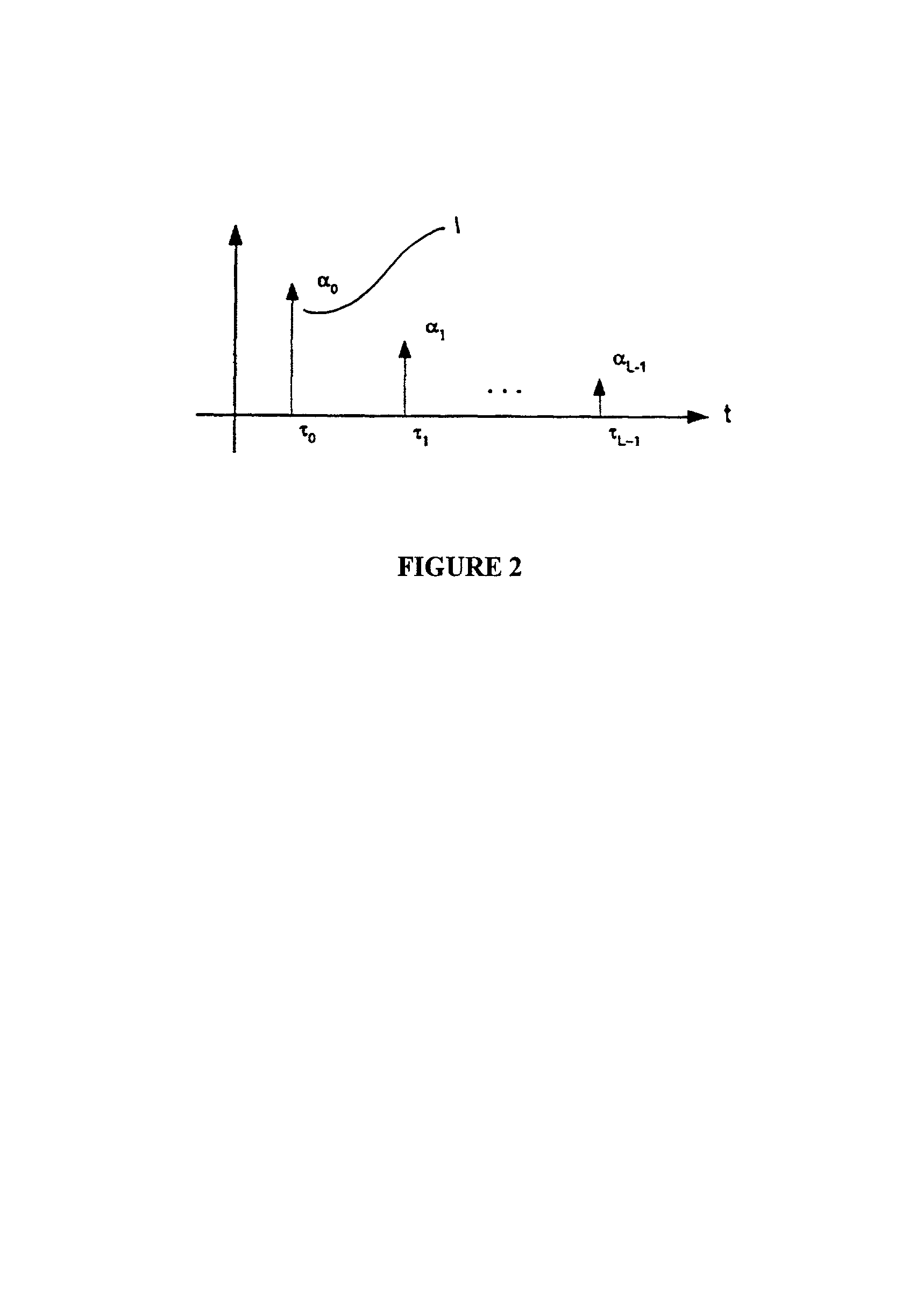Method for 2D antenna rake combining in a code division multiplication access system
a multi-access system and code division technology, applied in the field of wireless signal processing, can solve the problem of not being practicable to directly implement this algorithm
- Summary
- Abstract
- Description
- Claims
- Application Information
AI Technical Summary
Problems solved by technology
Method used
Image
Examples
example 1
[0059]Example 1 compares (i) the form of the combining coefficients produced from a current, state-of-the-art method where antenna combining is performed in series with MMSE RAKE combining with (ii) the form of the combining coefficients produced from the 2D RAKE methods of the current invention. The two methods in example 1 are compared for a hypothetical DS-CDMA receiver with two antennas and where each antenna receives 4 multipath pilot and data signals shown in FIG. 9. The despread pilot components may be defined as xij where i refers to the antenna number and j refers to the multipath component. The despread data components may be defined as dij where i refers to the antenna number and j refers to the multipath component.
[0060]In the preferred 2D RAKE methods according to the present invention, the vector form of the 2D RAKE combining coefficients may be expressed as:
W=Rxx−1rxp
Rxx=E(XXt) Equation 7
rxp=E(Xp*)
[0061]where W is an eight dimensional column vector W=[W1,1 W1,2 W1,3 ...
example 2
[0066]Example 2 illustrates that the 2D RAKE methods according to the invention preferably consider all the possible multipath component correlations in a dual antenna receiver. Example 2 also illustrates that the current, state-of-the-art MMSE-RAKE / Antenna combining methods do not consider all the possible multipath correlations in a dual antenna receiver and therefore the set of combining coefficients generated by the 2D RAKE methods are more optimal than the combining coefficients according to the current MMSE-RAKE / Antenna combining methods.
[0067]Example 2 assumes a dual antenna diversity receiver where one antenna receives three multipath signal components and the second antenna receives five multipath signal components. The channel profile considered in Example 2 is shown in FIG. 10. The despread multipath pilot signal components for antenna one may be written in vector form as X1=[x1,1x1,2x1,3]T. The despread multipath pilot signal components for antenna two may be written in ...
example 3
[0075]Example 3 compares SNR as a function of outage for a DSSS receiver using for the methods according to the invention and three current state-of-the-art methods. Outage may be defined as the percent of locations within the coverage area where a given SNR or other Quality of Service (QoS) can be guaranteed. The three state-of-the-methods examined are: 1) a one antenna receiver employing an MRC RAKE; 2) one antenna receiver employing an MMSE RAKE; and 3) a two antenna receiver employing an MMSE RAKE and MMSE antenna combining in serial.
[0076]Example 3 further assumes there are 13 users. The results of this experiment are summarized in FIG. 11. FIG. 11 shows that the preferred methods of the invention offer approximately two fold better SNR performance relative to the current state-of-the-art techniques where RAKE combining and antenna combining are performed in serial. Accordingly, if the preferred methods were implemented in a multi-antenna, DS-CDMA handset receiver, the preferre...
PUM
 Login to View More
Login to View More Abstract
Description
Claims
Application Information
 Login to View More
Login to View More - R&D
- Intellectual Property
- Life Sciences
- Materials
- Tech Scout
- Unparalleled Data Quality
- Higher Quality Content
- 60% Fewer Hallucinations
Browse by: Latest US Patents, China's latest patents, Technical Efficacy Thesaurus, Application Domain, Technology Topic, Popular Technical Reports.
© 2025 PatSnap. All rights reserved.Legal|Privacy policy|Modern Slavery Act Transparency Statement|Sitemap|About US| Contact US: help@patsnap.com



